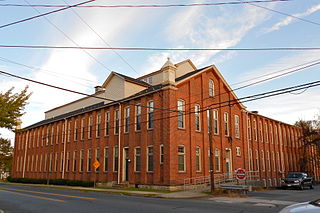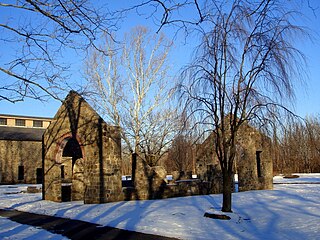
Catasauqua, referred to colloquially as Catty, is a borough in Lehigh County, Pennsylvania, United States. Catasauqua's population was 6,518 at the 2020 census. It is a suburb of Allentown in the Lehigh Valley, which had a population of 861,899 and was the 68th-most populous metropolitan area in the U.S. as of the 2020 census.
The Lehigh Valley Railroad was a railroad in the Northeastern United States built predominantly to haul anthracite coal from the Coal Region in Northeastern Pennsylvania to major consumer markets in Philadelphia, New York City, and elsewhere.

David Thomas was a native of Wales who was influential in the birth of the Industrial Revolution in the United States.
Anthracite iron or anthracite pig iron is iron extracted by the smelting together of anthracite coal and iron ore, that is using anthracite coal instead of charcoal in iron smelting. This was an important technical advance in the late-1830s, enabling a great acceleration of the Industrial Revolution in the United States and in Europe.
Fogelsville is a village in Lehigh County, Pennsylvania. It is a suburb of Allentown, in Upper Macungie Township, and is part of the Lehigh Valley, which has a population of 861,899 and was the 68th-most populous metropolitan area in the U.S. as of the 2020 census.
The Lehigh and New England Railroad was a Class I railroad located in Northeastern United States that acted as a bridge line. It was the second notable U.S. railroad to file for abandonment in its entirety after the New York, Ontario and Western Railway. It was headquartered in Philadelphia.

The Lehigh Crane Iron Company, later renamed Crane Iron Company, was a major ironmaking firm in the Lehigh Valley from its founding in 1839 until its sale in 1899. It was based in Catasauqua, Pennsylvania, and was founded by Josiah White and Erskine Hazard, who financed its development through their Lehigh Coal & Navigation Company, which promoted the then-novel technique of smelting iron ore with anthracite coal. This was an important cost and energy savings technique, credited with eliminating the need for either expensive charcoal or coke producing processes and transport costs that proved central to the acceleration of the American industrial revolution.

The Thomas Iron Company was a major iron-making firm in Hokendauqua, Pennsylvania in the Lehigh Valley region of eastern Pennsylvania from its founding in 1854 until its decline and eventual dismantling in the early 20th century.
Rittenhouse Gap is the name of a village in Longswamp Township in Berks County, Pennsylvania, United States, situated at 40°28′04″N75°37′47″W.
The Allentown Railroad was a railway company in the United States. It was incorporated in 1853 with the original intention to connect the Central Railroad of New Jersey at Allentown with the Pennsylvania Railroad's main line across the Allegheny Mountains. Though grading was almost entirely finished, the project was halted by the Panic of 1857, and the completion of the East Pennsylvania Railroad in 1859 made the Allentown Railroad's proposed line largely redundant. s a result, track was never laid on most of the line.

Lock Ridge Park is a park built around a historic iron ore blast furnace just outside Alburtis, Pennsylvania in the Lehigh Valley region of eastern Pennsylvania.

The Ironton Railroad was a shortline railroad in Lehigh County, Pennsylvania. Originally built in 1861 to haul iron ore and limestone to blast furnaces along the Lehigh River, traffic later shifted to carrying Portland cement when local iron mining declined in the early 20th century. Much of the railroad had already been abandoned when it became part of Conrail in 1976, and the last of its trackage was removed in 1984.

Lehigh Coal & Navigation Company was a mining and transportation company headquartered in Mauch Chunk, Pennsylvania, in present-day Jim Thorpe, Pennsylvania, in Northeastern Pennsylvania. The company operated from 1818 until its dissolution in 1964 and played an early and influential role in the American Industrial Revolution.
West Catasauqua is an unincorporated village in Whitehall Township in Lehigh County, Pennsylvania. Once a port and station along the busy Lehigh Canal, it is colloquially known as West Catty. It is part of the Lehigh Valley, which has a population of 861,899 and is the 68th-most populous metropolitan area in the U.S. as of the 2020 census.

Swabia Creek is a tributary of Little Lehigh Creek in Berks and Lehigh Counties in the eastern Pennsylvania region of the Lehigh Valley.

Josiah White (1781–1850) was a Pennsylvania industrialist and key figure in the American Industrial Revolution.

Biery's Port Historic District is a national historic district located in Catasauqua, Pennsylvania in the Lehigh Valley region of eastern Pennsylvania. The district was added to the National Register of Historic Places in 1984 and includes 90 contributing buildings in the Biery's Port section of Catasauqua.

There are two types of coal found in Pennsylvania: anthracite, the hard coal found in Northeastern Pennsylvania below the Allegheny Ridge southwest to Harrisburg, and bituminous, the soft coal found west of the Allegheny Front escarpment). Anthracite coal is a natural mineral with a high carbon and energy content that gives off light and heat produced energy when burned, making it useful as a fuel. It was possibly first used in Pennsylvania as a fuel in 1769, but its history begins with a documented discovery near Summit Hill and the founding of the Lehigh Coal Mine Company in 1792 to periodically send expeditions to the wilderness atop Pisgah Ridge to mine the deposits, mostly with notable lack of great success, over the next 22 years.

Catasauqua Creek is an ENE–SSW oriented creek draining 6.6 miles (10.6 km) from springs of the Blue Mountain barrier ridge several miles below the Lehigh Gap in the Ridge-and-Valley Appalachians located upriver and opposite from Allentown in Lehigh and Northampton counties in the Lehigh Valley region of eastern Pennsylvania.
The Catasauqua Branch was a short railway line in Lehigh and Northampton Counties in the state of Pennsylvania. It was part of the Lehigh and New England Railroad and ran from a point south of Bath to Catasauqua, where it interchanged with the Central Railroad of New Jersey and Lehigh Valley Railroad. The line opened in 1914 and was partially abandoned in 1961 on the Lehigh and New England Railroad's bankruptcy and closure. Conrail abandoned the remainder in the 1990s.











